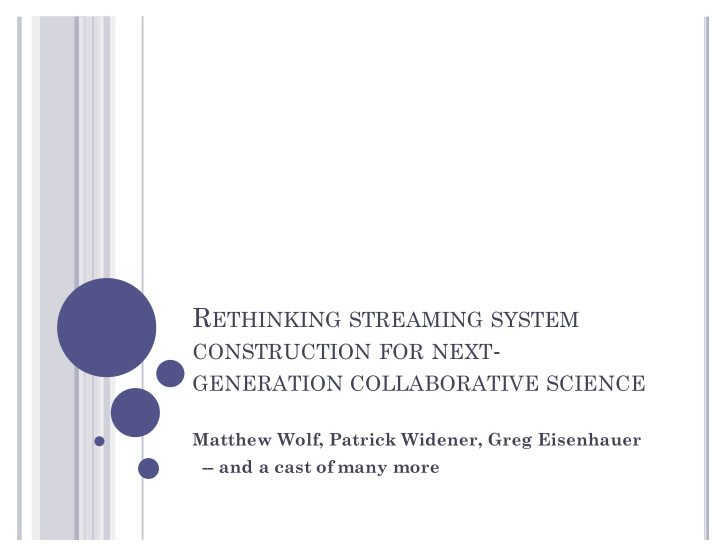



R ETHINKING STREAMING SYSTEM CONSTRUCTION FOR NEXT - GENERATION COLLABORATIVE SCIENCE Matthew Wolf, Patrick Widener, Greg Eisenhauer -- and a cast of many more
S TREAMING TO SUPPORT NEW SCIENCE -- B IG D ATA ’ S OTHER 4 V’ S ¢ Historically, a great deal of emphasis has been placed on batch processing of data-at-rest ¢ However, this focus has meant that scientists trying to do interactive or collaborative work have had to work with mismatched tools ¢ In particular, the steering/command and control functions in many scenarios gets short shrift Collaboration is more than sharing repositories Discovery, multi-disciplinary viewpoints on data, verification & gatekeeping on data
S TREAMING AT E XASCALE : THE RISE OF IN SITU Legend Workstation Data Movement Orchestrator Monitoring and Control Messages Global Orchestrator Codes Simulation GTS • Workstation GTC-P • Workstation Workstation Orchestrator Orchestrator LAMMPS • Workstation Orchestrator PIConGPU • Pixie3D • S3D • Einstein Toolkit • Analysis Analysis Analysis … • Workstation Workstation Workstation Storage Thanks: Jai Dayal, Scott Klasky, Hasan Abbasi, Fang Zheng, Norbert Podhorski, KarstenSchwan, Manish Parashar, Jay Lofstead…
Z OOM -I N A NALYSIS VMWare, Amazon, DOE Detect E2E Transaction Anomaly Detection Response Time Anomaly DCG 1: Aggregation Lightweight SLO SLO Anomaly Anomaly metrics metrics Detection Detected! Cloud Hosting Web Services FS1 FS2 FS3 AS DS AS DS AS DS 3 3 1 1 2 2 PRN: Network Traffic Trigger Zoom-In Zoom-In Tracing Analytics Heavyweight Casual Path Inference Analysis Bottleneck Identification DCG 2 Localizing DS3 as the source Highly reduced data overhead and focus on problematic area Thanks: Chengwei Wang, Drew Bratcher, KarstenSchwan, and many more.
S OFTWARE S OLUTION : AN E VENT P ROCESSING T OOLKIT • http://evpath.net & http://korvo.gatech.edu/software • EVPath is an Open Source event processing A http://korvo.gatech.edu/projects/MON Matthew Wolf - infrastructure designed for high performance • A component of the SDAV SciDAC institute • Allows the construction of application-level overlay networks with embedded computation MONA - • Fully-typed data flows along the path • Very low overhead self-describing binary data • Dynamic code generation for on-the-fly processing • Flexible network infrastructure allows run-time selection and parameterization of network transport • Toolkit that supports construction of CDN-like, 5 DHT-like, aggregation-tree-like, asynchronous, p2p, or other steering infrastructures
A N I LLUSTRATIVE E XAMPLE : E XPERIMENTAL C OMBUSTION C OLLABORATION • Science goal is to understand the complex dynamics of different fuel mixes, speeds, acoustic interactions, and so on • Use laser probes and cameras at 10k+ frames per second • Inject particles so you can trace fuel, flame, and residue in real time. • Initial process was driven by disk I/O & storage transport Thanks: Tim Lieuwen, Ben Emerson, Vishal Acharya, Jonathan Frank, Akash Gagnil, Drew Bratcher
¢ Stream processing lets us address a number of critical issues: Are the lasers properly aligned? Did someone bump something? Are the particle injectors working correctly? Are there any obvious experimental defects in the data (i.e. chunks of foam)? Does this look approximately right for the input parameters (i.e. did someone leave a wrench in the inlet)? Has the effect we’re looking at saturated? Should we change the next parameter test in the campaign? Does this line up with what we know from simulation? Should I adapt the campaign to better probe the difference? Are the Physical Chemists right?
S CI K HAN – AN I NITIAL DEMONSTRATION The interactions between data-in-motion and data-at-rest • (thanks, IBM!) can be complicated. Scientists wanted the stream-based capabilities, but they were • used to a file system interface.
C ONCLUSION ¢ The data management problem is beyond just large Volume. Streaming has been treated as a corner case for a long time Critical gap when all 5 V’s (volume, velocity, variety, value and veracity) are in play ¢ Steering and/or control requires highly specialized designs for each of the users Use a toolkit that allows that customization ¢ Human-in-the-loop, delegated control, etc. ¢ There is a change management problem The science questions and the way science is conducted can change as the technology shifts
Recommend
More recommend